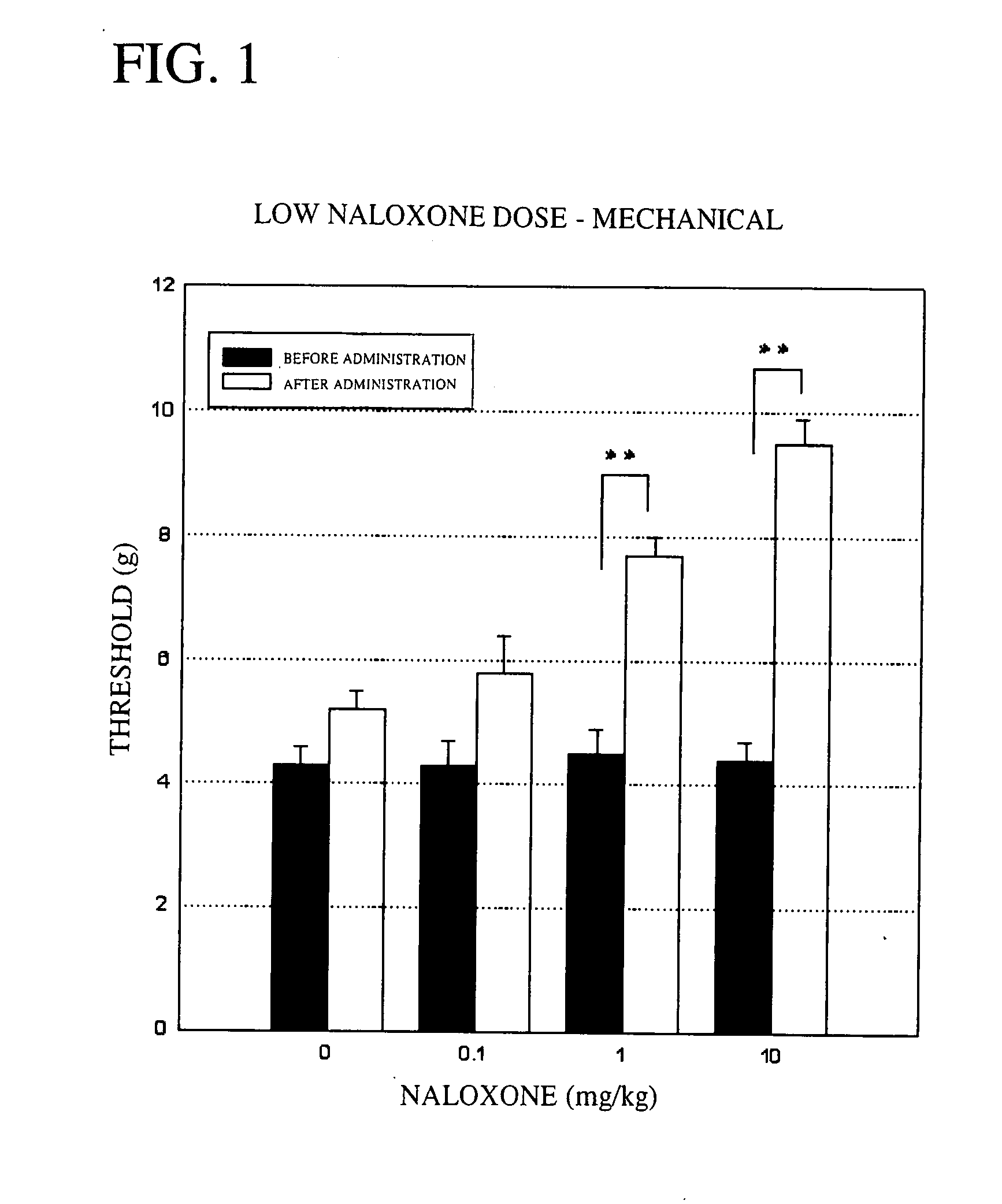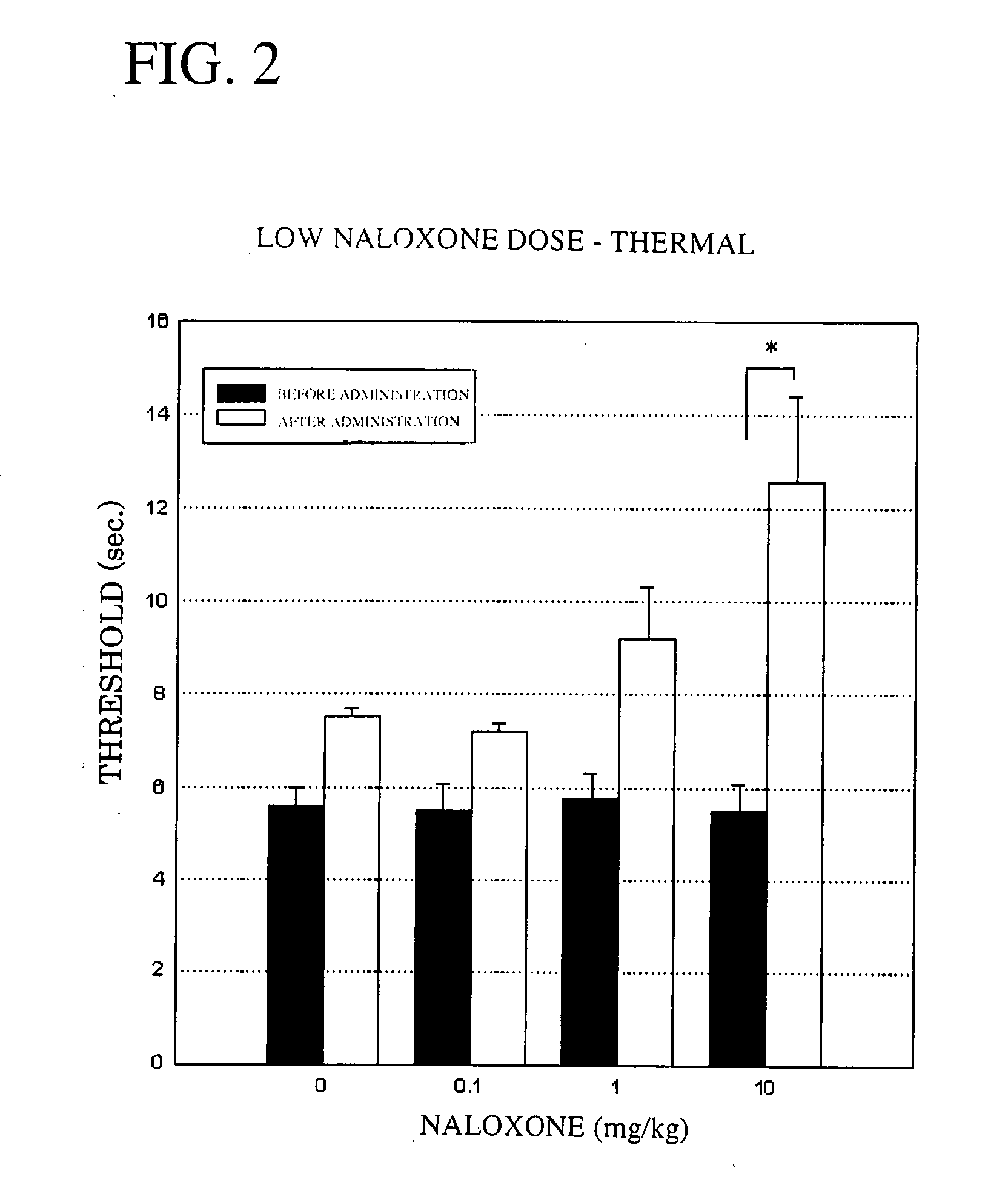Therapeutic Agent for Neuropathic Pain
a neuropathic pain and therapy agent technology, applied in the field of neuropathic pain therapy agents, can solve the problems of insufficient effectiveness of opioid receptor agonists such as morphine, inability to achieve the effect of reducing pain, insufficient effectiveness of analgesics which work well for ordinary nociceptive pain (particularly narcotic analgesics), and insufficient safety of use in humans
- Summary
- Abstract
- Description
- Claims
- Application Information
AI Technical Summary
Benefits of technology
Problems solved by technology
Method used
Image
Examples
example 1
Mechanical Stimulation Method—Low Dose Study:
[0053] Groups of five male rats (333.7 to 414.2 g) in which the hyperalgesia model had been induced were used. An aesthesiometer set to a maximum pressure of 15.0 g and to a time until the maximum pressure is reached of 20 seconds was used to measure the left plantar pain threshold before naloxone administration, and 20 minutes, 40 minutes and 60 minutes after administration. The results are shown in FIG. 1. In the figure, “**” shows the significant difference at P<0.01 based on Dunnett's multiple comparison test, and “*” shows the significant difference at P<0.05 based on Dunnett's multiple comparison test.
[0054] As shown in FIG. 1, in a control group administered physiological saline, the maximum pain threshold following administration was 5.2 g. By contrast, in the groups administered naloxone, (a) at a dose of 0.1 mg / kg, the maximum threshold following administration was 5.8 g; (b) at a dose of 1 mg / kg, the maximum threshold follow...
example 2
Thermal Stimulation Method—Low Dose Study:
[0055] Groups of five male rats (356.7 to 444.0 g) in which the hyperalgesia model had been induced were used. A plantar thermal stimulation tester set to a thermal stimulation intensity of 35 was used to measure the left plantar pain threshold before naloxone administration, and 20 minutes, 40 minutes and 60 minutes after administration. The results are shown in FIG. 2.
[0056] As shown in FIG. 2, in a control group administered physiological saline, the maximum pain threshold following administration was 7.5 seconds. By contrast, in the groups administered naloxone, (a) at a dose of 0.1 mg / kg, the maximum threshold following administration was 7.2 seconds; (b) at a dose of 1 mg / kg, the maximum threshold following administration was 9.2 seconds; and (c) at a dose of 10 mg / kg, the maximum threshold following administration was 12.6 seconds. The pain threshold thus rose significantly with the administration of 10 mg of naloxone, demonstratin...
example 3
Mechanical Stimulation Method—High Dose Study:
[0057] Groups of five male rats (372.0 to 459.5 g) in which the hyperalgesia model had been induced were used. An aesthesiometer set to a maximum pressure of 15.0 g and to a time until the maximum pressure is reached of 20 seconds was used to measure the left plantar pain threshold before naloxone administration, and 20 minutes, 40 minutes and 60 minutes after administration. The results are shown in FIG. 3.
[0058] As shown in FIG. 3, in a control group administered physiological saline, the maximum pain threshold following administration was 6.2 g. By contrast, in the groups administered naloxone, (a) at a dose of 30 mg / kg, the maximum threshold following administration was 10.4 g; (b) at a dose of 60 mg / kg, the maximum threshold following administration was 10.6 g; and (c) at a dose of 120 mg / kg, the maximum threshold following administration was 10.3 g. The pain threshold thus rose significantly with the administration of naloxone, ...
PUM
| Property | Measurement | Unit |
|---|---|---|
| Mass flow rate | aaaaa | aaaaa |
| Mass flow rate | aaaaa | aaaaa |
| Therapeutic | aaaaa | aaaaa |
Abstract
Description
Claims
Application Information
 Login to View More
Login to View More - R&D
- Intellectual Property
- Life Sciences
- Materials
- Tech Scout
- Unparalleled Data Quality
- Higher Quality Content
- 60% Fewer Hallucinations
Browse by: Latest US Patents, China's latest patents, Technical Efficacy Thesaurus, Application Domain, Technology Topic, Popular Technical Reports.
© 2025 PatSnap. All rights reserved.Legal|Privacy policy|Modern Slavery Act Transparency Statement|Sitemap|About US| Contact US: help@patsnap.com



